
Seeing 50 species of birds on an early summer day in lowland England isn’t difficult, but on the moors of the Pennines – the rugged hills that form the spine of northern England – it’s not so easy. However, this was the challenge that my companion Gerry Madden and I set ourselves when we set off from the village of Romaldkirk, in the county of Durham, on a day earlier this month. We made a leisurely start, not setting off until 9.30. Yes, we could have started at dawn, which was around five hours earlier, but this wasn’t going to be a day of hard listing, but a more gentlemanly tour of Teesdale and Swaledale. Though the sun shone as we set off, the car’s temperature gauge indicated a chilly 5degC, which, coupled with a biting northerly wind, meant it felt closer to freezing.

Meadow Pipits are abundant breeding birds on the moors
Romaldkirk produced most of the village birds we could expect: there were House Martins and Swifts, Chaffinches and House Sparrows, plus Jackdaws on the church (which dates from Saxon times, more than a thousand years ago). The pretty village is surrounded by the high hills of the Pennines, so we soon found ourselves driving through a mixture of cattle-grazed pastures and heather moorland, and our next three birds were all waders that depend on the moors for their nesting habitat. The first was a Curlew (the first of many seen during the day), quickly followed by several Lapwings and a Redshank, the latter sitting on a roadside post. Families of Starlings with freshly fledged chicks were feeding in the fields, along with Carrion Crows and Meadow Pipits.
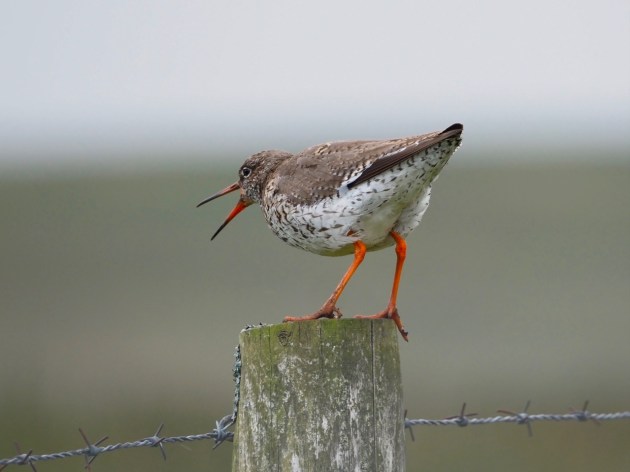
A Redshank scolds from a roadside fence
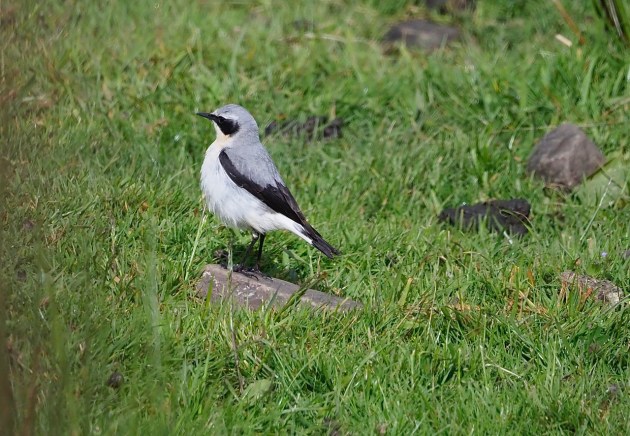
A cock Northern Wheatear

A recently fledged Lapwing. These waders, along with Curlew, Redshank and Golden Plover, benefit from predator-control on the keepered grouse moors
Our route took us along the edge of a wood, and here we added both Willow Warbler and Chiffchaff to the list. These two small warblers look very similar to each other, so song is the easiest way to tell them apart, though they have different habitat preferences. Willow Warblers favour the more open habitat, with low trees and scrub, while the Chiffchaff prefers more mature woodland. The Willow Warbler’s gentle lilting song is one of the most characteristic sounds of the hills.
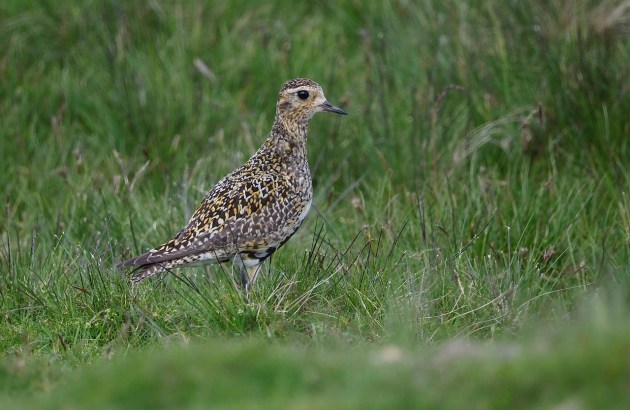
Golden plovers (above and below) nesting in Britain lack the black faces of more northerly populations

New birds came rapidly, so we were soon up to 25 species, with notable additions ranging from Wheatear to Oystercatcher. We paused for a while by a small stream, winding its way down to the River Tees from which the valley below takes its name, and here we soon found Grey Wagtails, the most elegant of birds, along with Pied Wagtails, Stonechats and Sand Martins. The latter nest in the low sand banks that edge the stream. The moorland colonies are always small, rarely more than a few pairs, but it’s always a delight to see these birds hawking over the babbling burns.

Pied Wagtails nest along the moorland streams in company with Grey Wagtails
It was a stop for a Red-legged Partridge, a bird that is widely released in the area for shooting, that produced our first sighting of our main target bird, Black Grouse. There were four splendid cocks, feeding in a field a few hundred yards away. Though they were easily picked up with binoculars I put the scope up so we could enjoy them, for these handsome game birds are a special bird of the area, and never an easy one to see. Two centuries ago Blackgrouse were widely distributed in England, and were even quite common. Today their population is fragmented and much reduced, and it’s only due to serious conservation work that they survive on the moors today. Though they remain a legal quarry species, they are rarely shot.
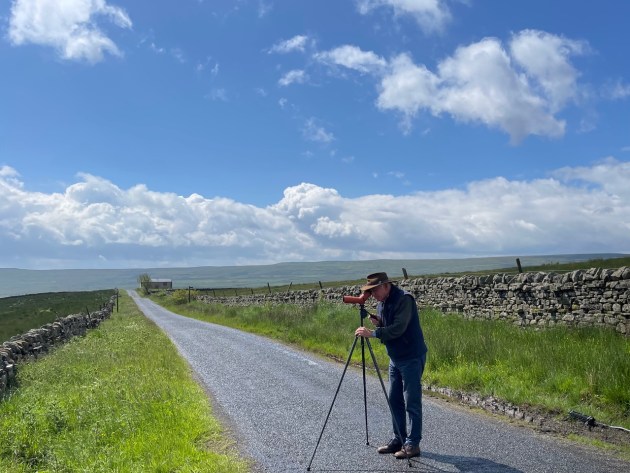
Scoping from the road for Black Grouse. Quiet moorland roads mean that you are seldom disturbed by passing traffic. The blue sky and sunshine is misleading: it was unseasonably cold

The haunting song of the Curlew is a familiar sound in spring on the grouse moors
Surprisingly, we saw these Black Grouse before finding our first Red Grouse, for the latter is by far the more numerous of the two. The high hills of the Pennines are managed for grouse shooting, giving an economic value to land that would otherwise be of little use except for grazing sheep or possibly planting with exotic conifers. The grouse season opens on 12 August: the birds are shot by driving them over the waiting guns (to call them hunters is inappropriate, as they are merely shooters, as no hunting is involved). Driven-grouse shooting is a very expensive sport, and is disliked by many people who would like to see it banned. However, nesting waders such as Lapwings, Curlew and Golden Plover all thrive on the grouse moors, benefitting from the predator control and heather management carried out by the gamekeepers. Banning grouse shooting would be very bad news for a host of birds, many of which are red-data species that are both threatened and declining.

More typically a coastal-breeding bird, Oystercatchers nest commonly on the Pennine moors
On this day we saw surprisingly few grouse, probably because the chilly wind and low temperatures forced them to keep their heads down. I was hoping for some good photo opportunities, as they are usually easy birds to photograph from a car, but few obliged. However, we did come across two more Blackcock, one of which sat on a roadside stonewall long enough for me to shoot him with the camera.

Blackcock – one of the most sought-after birds of the Pennine Hills. This individual, perched on a stonewall, was photographed from the car

A cock Red Grouse, economically by far the most important bird of the moors

The wood beside the Bollihope Burn held Spotted Flycatchers, Siskins and a Crossbill. Though it looks warm and sunny, it was cold with a biting northerly wind
The most enjoyable birdwatching was when we explored a small wood adjoining the Bollihope Burn, a tributary of the Wear. The bitter wind was still blowing – my photographs give a misleadingly summery look to the wood – and as a result a number of birds were sheltering here. I soon found a Spotted Flycatcher, now a very scarce summer visitor to England, and went on to find several more. There was a Common Sandpiper on the burn, along with a Mallard duck with a single duckling. Siskins called overhead, and once a Crossbill flew in and we enjoyed a good but fleeting view. A single Goldcrest was another useful addition to the list, and our 46th species, followed by Lesser Black-backed Gull and an overdue Wren.

A Spotted Flycatcher hawking for insects along the Bollihope Burn
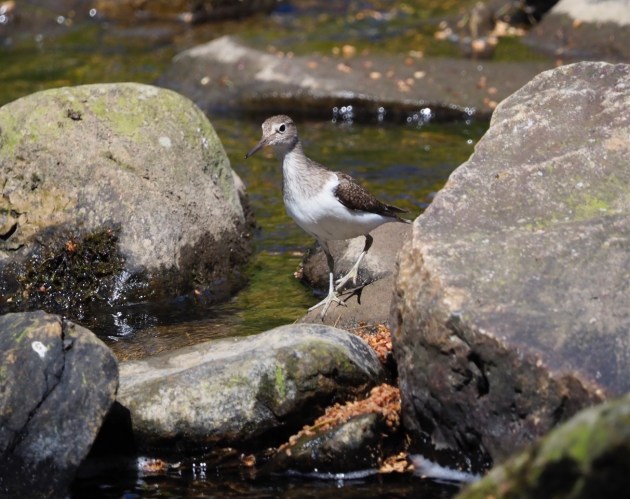
Common Sandpipers breed beside the moorland burns. This bird was on the Bollihope Burn
It was tempting to wander a little on to the moor in search of Ring Ouzels, but we hadn’t gone far when the sky darkened. The wind strengthened, blowing furiously, and then the rain hit us. We struggled back to the car, giving up on the unseen Ouzels. It felt more like February than June.
Fortunately the storm passed as quickly as it has arrived, and now, with the score on 48, we were closing in on our target. There weren’t many obvious possibilities remaining, but a tarn (lake) we could view from the road produced an unexpected pair of Tufted Ducks, along with two pairs of Little Grebes. Success! We had achieved our half century, despite not seeing a single Blue or Great Tit during the day. We made our way back to the pub, the Rose and Crown in Romaldkirk, for a celebratory supper, ticking off a Collared Dove as we drove. There were no more additions, so 51 was our final score.
Our day was spent largely on quiet moorland roads where we rarely saw another car, but we had covered a good few miles during the day, so I was indebted to Gerry for doing all the driving. Being driven is a rare luxury for me, and did make my photography easier, for most of the pictures illustrating this piece were taken from the passenger seat. My thanks go to Gerry (whom I first took out birdwatching more than half a century ago) for suggesting we should meet up for a day on the moors, and for ensuring we had such a good time. Those Blackcock were a rare treat, and well worth the long drive from my home 200 miles away in Suffolk.










My family and I lived in Teesside in the early nineties. Margaret Thatcher was still in charge, unemployment was at 30% and steel was being produced to the detriment of clean air… My youngst son is a Yorkshireman. I am happy to see you visited Swaledale as most tourists will visit the friendlier Wensleydale. I always liked Swaledale. The bleakness and raw beauty. Never ever saw a blue sky nor a temperature above 20 deg C… I still miss it!